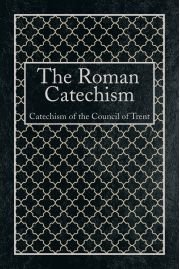The Roman Catechism of the Council of Trent - Hardcover - 608 pages - 6" x 9"
Catechism of the Council of Trent for Parish Priests - Issued by Order of Pope St. Pius V
Translated by order of Pope St. Pius V.
English translation and notes by John A. McHugh, O.P. and Charles J. Callan, O.P.
Easy to read modern typesetting.
Foreword by Charles A. Coulombe
“Catechesis,” in the sense of teaching the truths of the Faith, is as old as the Catholic Church; Christ Himself was the first and best of our catechists. Indeed, catechesis and evangelisation are inseparable, and always have been. But “catechisms,” in the way we think of them, are a relatively new phenomenon. It was in fact the Protestant Revolt that launched the genre–starting with Martin Luther’s large and short catechisms, in which he laid out his mixture of truth and heresy in a simple question and answer format. In rapid succession, this method was used by Calvinists and others for the same purpose–Cranmer even composed one for the Book of Common Prayer. It turned out to be a devastatingly effective method. Not too surprisingly, beleaguered Catholics responded in kind, St. Peter Canisius, for example, producing one in 1555.
Aware of this background, the Fathers of the Council of Trent decided that a basic catechism explaining the truths of the Faith was an urgent necessity. At the suggestion of St. Charles Borromeo, on February 26, 1562 the Council Fathers resolved that “to apply a salutary remedy to this great and pernicious evil, and thinking that the definition of the principal Catholic doctrines was not enough for the purpose, resolved also to publish a formulary and method for teaching the rudiments of the faith, to be used by all legitimate pastors and teachers.” Thus, the idea was not to publish a popular catechism for everyone to read, but to produce a resource that would allow priests to use it in teaching their people. To be taken primarily from the Council texts, Pius IV entrusted the composition of the work to four theologians: the distinguished Papal diplomat, Archbishop Leonardo Marini of Lanciano; the Knight of Malta, Archbishop Muzio Calini of Zara; Bishop Egidio Foscherari of Modena, renowned for his work with orphans; and the Portuguese Dominican Francisco Foreiro, theologian, Biblicist, and close collaborator with several of his country’s Kings.
St. Charles Borromeo supervised the whole work, and it appeared at last in 1566.
The Council Fathers intended that their catechism should have a definite weight. Thus we read in the seventh canon, De Reformatione, of Sess. XXIV: “That the faithful may approach the Sacraments with greater reverence and devotion, the Holy Synod charges all the bishops about to administer them to explain their operation and use in a way adapted to the understanding of the people; to see, moreover, that their parish priests observe the same rule piously and prudently, making use for their explanations, where necessary and convenient, of the vernacular tongue; and conforming to the form to be prescribed by the Holy Synod in its instructions (catechesis) for the several Sacraments: the bishops shall have these instructions carefully translated into the vulgar tongue and explained by all parish priests to their flocks...”.
Although subsequent centuries would see any number of Catholic catechisms written for the laity by various writers and authorities, this Roman or Tridentine catechism remained the basic standard and the most authoritative – not least because so much of it was taken directly from the Council. In 1979, Pope John Paul II spoke of it as the “Roman Catechism, which is also known by the name of that council [Trent] and which is a work of the first rank as a summary of Christian teaching and traditional theology for use by priests.”
Of course, it was John Paul II who commissioned the Catechism of the Catholic Church which in the minds of many has replaced or eclipsed the Roman Catechism. But this would be a grave mistake. Whereas most of the former comes more or less directly from the Council and so has a certain level of solemnity, the CCC is decidedly a mixed bag. What was written about the Compendium of the Social Doctrine of the Church by its authors is also true of the CCC: “In studying this Compendium, it is good to keep in mind that the citations of Magisterial texts are taken from documents of differing authority. Alongside council documents and encyclicals there are also papal addresses and documents drafted by offices of the Holy See. As one knows, but it seems to bear repeating, the reader should be aware that different levels of teaching authority are involved.” For reasons having to do with modern fashions in theology, there are a few places where the two documents contradict each other quite plainly.
The most notable of these is the question of the necessity of Baptism. The Roman Catechism’s Question XXX, “Baptism is necessary to all unto salvation” states that “If the knowledge of the matters which have been hitherto explained is to be deemed most useful to the faithful, nothing can appear also more necessary than that they be taught that the law of baptism is prescribed by our Lord to all, insomuch that they, unless they be regenerated unto God through the grace of baptism, whether their parents be Christian or infidel, are born to eternal misery and perdition. The pastor therefore must give a frequent exposition of these words of the Gospel: Except a man be born again of water and the Holy Ghost, he cannot enter into the kingdom of God.” The CCC, on the other hand, for the same question, tells us “The Lord himself affirms that Baptism is necessary for salvation. He also commands his disciples to proclaim the Gospel to all nations and to baptize them. Baptism is necessary for salvation for those to whom the Gospel has been proclaimed and who have had the possibility of asking for this sacrament. The Church does not know of any means other than Baptism that assures entry into eternal beatitude; this is why she takes care not to neglect the mission she has received from the Lord to see that all who can be baptized are ‘reborn of water and the Spirit.’ God has bound salvation to the sacrament of Baptism, but he himself is not bound by his sacraments. The Church has always held the firm conviction that those who suffer death for the sake of the faith without having received Baptism are baptized by their death for and with Christ. This Baptism of blood, like the desire for Baptism, brings about the fruits of Baptism without being a sacrament. For catechumens who die before their Baptism, their explicit desire to receive it, together with repentance for their sins, and charity, assures them the salvation that they were not able to receive through the sacrament. ‘Since Christ died for all, and since all men are in fact called to one and the same destiny, which is divine, we must hold that the Holy Spirit offers to all the possibility of being made partakers, in a way known to God, of the Paschal mystery.’ Every man who is ignorant of the Gospel of Christ and of his Church, but seeks the truth and does the will of God in accordance with his understanding of it, can be saved. It may be supposed that such persons would have desired Baptism explicitly if they had known its necessity. As regards children who have died without Baptism, the Church can only entrust them to the mercy of God, as she does in her funeral rites for them. Indeed, the great mercy of God who desires that all men should be saved, and Jesus' tenderness toward children which caused him to say: ‘Let the children come to me, do not hinder them,’ allow us to hope that there is a way of salvation for children who have died without Baptism. All the more urgent is the Church's call not to prevent little children coming to Christ through the gift of holy Baptism.”
These two statements are in large flat out contradictory (indeed, there are internal contradictions in the CCC’s own text). But the Roman Catechism simply reflects explicitly the defined teaching of the Council of Trent, whereas–as a perusal of the CCC’s footnotes shows–the latter document’s sources are of far less authority. Indeed, the most contradictory statements are not footnoted at all, but must be assumed to be the opinions of the CCC’s authors–and thus, in and of themselves, of no weight when contradicting the Roman Catechism.
But it would be a second error to presume on that account that the CCC is worthless. Save in those very few areas where it contradicts Trent, it explores in a very orthodox way many issues that have arisen since Trent, and also cites Eastern Catholic teaching and worship in a way that helps bring out very clearly the universality of Catholic doctrine.
Those things having been said, it would seem to this writer that the well-prepared Catholic catechist would begin by reading and making his own the Roman Catechism, in the light of which he would then read the CCC. Afterwards, he could then use the St. John Neumann, Baltimore, or any other catechism for actual teaching in the proper light.
But the Roman Catechism remains the gold standard and the essential place to start for anyone undertaking the essential role of catechist. Loreto Publications is to be thanked for once again making easily available to the public an essential document in the life of the modern Church that is only too often allowed–as with so many other things–to slide into obscurity.
Charles A. Coulombe
Trumau, Austria
July 1, 2022
Feast of the Most Precious Blood of Jesus
No posts found






